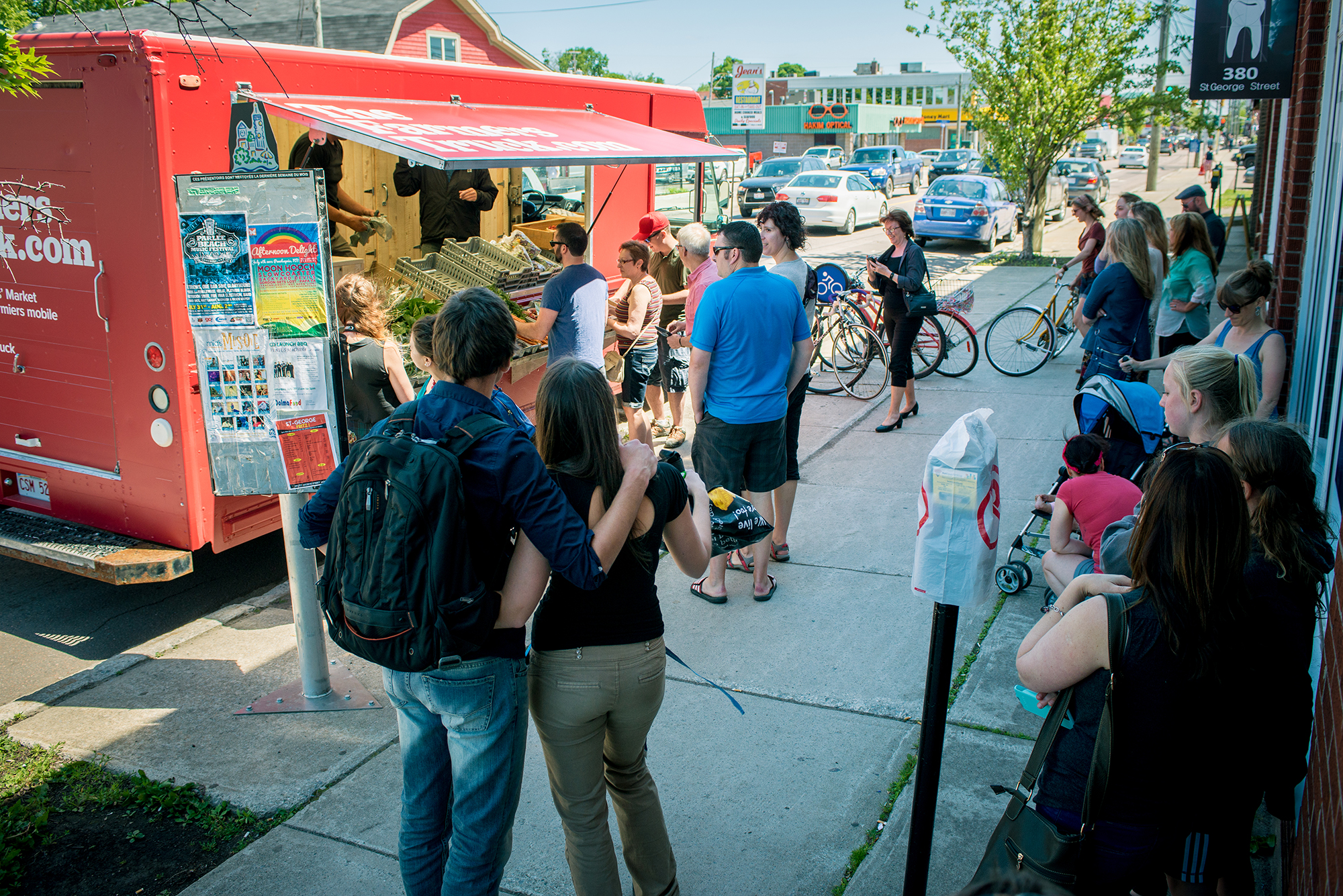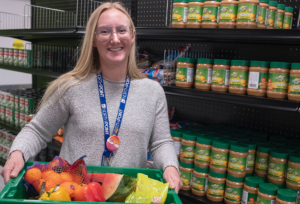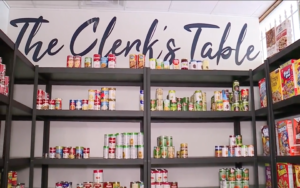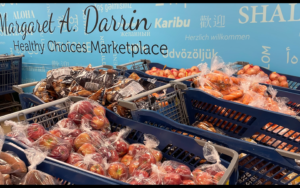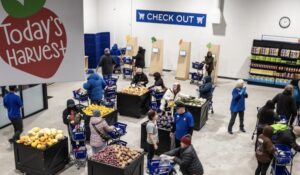Like a farmer’s market on wheels, mobile food markets have emerged in recent years as handy solutions for organizations seeking to bring fresh produce to vulnerable populations. Yet the pantries are not without their Achilles’ heels, as organizations have sometimes struggled to find the appropriate mix of product, pricing, location and funding to sustain their mobile programs.
Early on, some mobile markets were failing because they pursued poor financial propositions, said Lucia Leone, Ph.D., Associate Professor of Community Health and Health Behavior at the University at Buffalo, who in 2018 helped launch The Veggie Van, a mobile market turned training and development resource. “Most were trying to use locally grown produce — working with small farmers and paying premium prices because they wanted to support those farmers,” Leone said. “But paying premium prices and selling affordably is out of balance.”
The mobile model can be difficult, but on the whole it checks all the right boxes, said Frederic Laforge, Co-Founder and CEO of The Farmers’ Truck, which empowers organizations to run mobile markets. Nonprofits “are not used to running a labor-intensive retail operation,” he noted.
Even so, mobile markets are cost-effective compared to brick-and-mortar stores, Laforge said, and can be financially viable if run properly. “These markets are mobile, and go where needed. They focus on fresh healthy food, keep prices affordable, and people are knowledgeable,” he said. “Shoppers can learn about cooking or how to feed themselves better.”
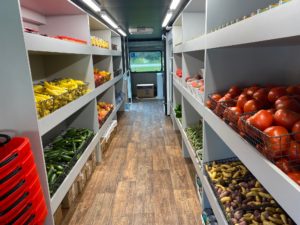
There are many different ways to run a mobile market, and organizations must address a myriad of issues, including the type of vehicle to purchase. An ongoing question is whether to charge a modest amount for the food or provide it for free. “Some think they should be giving food for free, (and) there’s a need for that, but most (people) would rather pay,” Laforge said.
One school of thought is that the exchange of money increases dignity, which improves customer mentality, food quality, community involvement, and financial sustainability. “A big tenet for doing paid food comes down to quality,” Leone said. “When we talked to people, they didn’t want leftovers. Just because they’re poor, they still want high quality.”
Even so, the “free food” model still bears significant weight. Emma Inman, Chief Impact Officer of the Food Bank of Southeast Virginia and the Eastern Shore, said it has offered free boxed items for more than 10 years, giving away 1.4 million pounds of food through mobile distribution in 2019. In June, it launched its fleet of four 757 Mobile Markets, which offer client choice, with an annual budget of $360,000, distributing 35,238 pounds of fruits and vegetables in just three months during 12 weekly stops.
Importantly, the food bank’s mobile pantries offer a high-quality experience, even though the food is free of charge. “There is a certain dignity to having the same kind of shopping experience that anyone else will have,” Inman said. “We’re hearing that people didn’t expect to have the same quality of produce as a higher end grocery store. They were expecting donated product.”
Wayside Food Programs in Portland, Me., has been packing five meals per person into its free food boxes, supplementing the diets of 300 to 400 individuals, or up to 200 households, at five monthly mobile pantries since 2011. Because it’s a food rescue site and depends on donations, the food it receives is what it distributes, aside from $20,000 in eggs it purchases, said Executive Director Mary Zwolinksi.
Wayside’s entry into mobile food distribution underscores how unfamiliar the mobile model can be. Initially, Wayside “didn’t know what we were trying to do,” Zwolinski said. “We didn’t know what kind of information we wanted to capture. We didn’t have a good way of promoting it, besides just showing up with a van and letting people know they could take food. We didn’t put a lot of thought into curating what those foods were. But we have adjusted, and it did get us thinking about how we serve people that can’t come to us and may not have access to food pantries.”
The type of mobile vehicle is a consideration. Laforge’s Farmer’s Truck vehicle displays food outside in small baskets under a pop-up awning, and also offers refrigerated storage units inside. Food Bank of Southeast Virginia and the Eastern Shore chose large refrigerated trucks inside which customers shop, but drivers need a commercial license to operate it, which can be limiting.
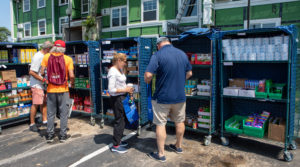
The Dr. Martin Luther King Jr. Community Center in Newport, R.I, uses a smaller refrigerated truck and treats it like a walk-in cooler, wheeling out large shelves for al fresco shopping. “This allows us to keep more food in stock, instead of reloading and starting from square one every day,” said Executive Director Heather Hole Strout. “Having a designated vehicle is crucial to the efficiency and success of this program.”
In 2018, MLK’s mobile start-up costs totaled $110,000, which supported distributions of local milk and farm-grown produce. In 2020 it distributed 150,000 pounds of produce at more than 135 events, averaging 250 monthly household visits. Strout anticipates doing triple that amount in 2021, with a $410,000 budget and $60,000 from grants and private donors, and less than one percent coming from municipal, state and federal sources. The organization also sells sponsorship opportunities for $1,000, which is the cost to operate one mobile food pantry event.
In Pennsylvania, Chester County Food Bank has held six weekly and four monthly Fresh2You mobile markets since 2015, selling produce to about 2,000 people annually. Because the food bank grows most of what it sells, including 100,000 pounds of produce from two farm locations, a family of four can buy a week’s worth of produce for less than $40.
Despite the challenges, including finding the appropriate vehicle and outfitting it properly — a price tag of more than $100,000 — as well as locating suitable host sites, and securing ongoing support, Chester County is sold on mobile markets. “Being mobile allows us to serve the most amount of people and keep things moving around the county,” said Chief Development Officer Patricia Campbell. “The mobile market is our answer.”
The need to serve struggling communities will sustain mobile market programs, participants agreed.
“We’re out to provide what people can’t get, and what they need and want,” Campbell said. “Like any other subsidy program, we exist because a business or government will not do this, because it doesn’t make profitable business sense. These programs will always need to be subsidized. We will always need funders and supporters. Thankfully, the benefit far outweighs the true cost.”
Leone said mobile markets will persevere if only because they are a key component to addressing food access. But it must be the right type of organization that takes on the right challenge with the right motivation, empowered with the right training and funding, she said.
Mobile pantries are here to stay, in the view of Inman of the Food Bank of Southeast Virginia and the Eastern Shore. “It is addressing a need in our community and we will sustain it,” she said. “It is too important not to.” — Annie Sherman
Annie Sherman is a freelance journalist in Newport, R.I., covering topics at the intersection of food sustainability, the environment, business, and regional lifestyles. She penned “Legendary Locals of Newport” and is the former editor of Newport Life magazine.
CAPTION ABOVE: The Farmer’s Truck mobile market features a pop-up awning.
Like what you’re reading?
Support Food Bank News